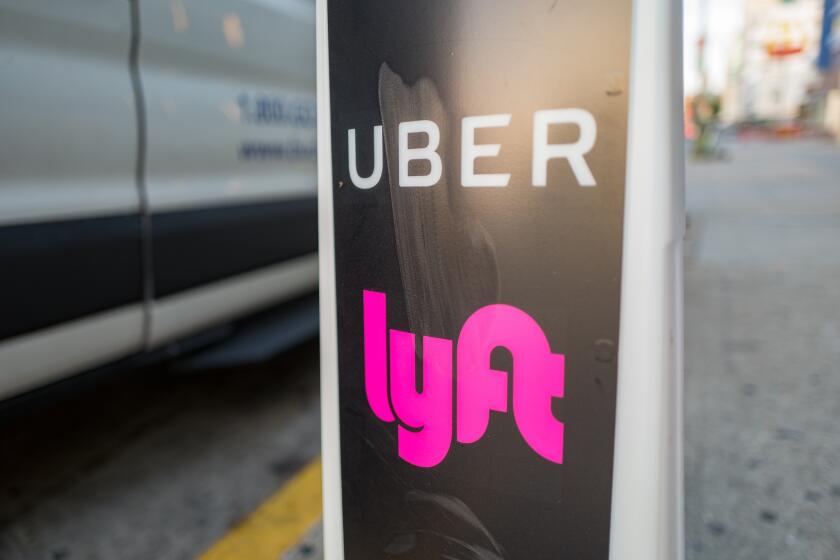THE TIMES 100 : THE BEST PERFORMING COMPANIES IN CALIFORNIA : SECTOR BY SECTOR : Big Isn’t Bad But Small, In Business, Is Beautiful : Entrepreneurs: The O’Briens left 9-to-5 jobs to open Catalina Foods in 1990. They’re part of a Southern California tidal wave.
- Share via
For all the attention paid to big business, it’s worth remembering E. F. Schumacher’s observation on the subject: “Small is beautiful.”
Consider a marriage made in business. He was an investment specialist and she was a retail manager. They chucked their corporate careers and formed a professional, as well as personal, partnership--in their own small business.
In doing so, they went from working five days a week to seven. They have to worry about every facet of their fledging food business, from the payroll to the deliveries, but Laurie O’Brien says she and husband Richard will never turn back.
“It is knowing you are building value for family and your kids,” she says.
The O’Briens, who started Catalina Foods in Newport Beach two years ago to make and market ready-to-cook tortillas, are among the thousands of small-business owners who one day may be big-business owners.
While The Times 100 companies account for a disproportionate share of power and jobs, they are collectively dwarfed by the total number of small businesses--the dry cleaners, apparel designers, restaurant owners, to name a few--that form the backbone of Southern California’s employment base.
One in eight American small businesses is in Southern California, according to a report by Wells Fargo Bank in 1990. The study also found that firms with fewer than 50 employees accounted for a third of all new jobs between 1983 and 1988.
Virtually every Times 100 company, the titans of the California business world, has its own story of humble beginnings.
Take No. 42, Price Club, based in San Diego. It was started as a single cash-and-carry warehouse store by founder Sol Price in 1976. Since then, it has grown into one of retailing’s hottest chains. Net income last year was $65 million.
Or No. 13, Quiksilver Inc. of Costa Mesa. Robert B. McKnight and professional surfer Jeff Hakman saw the need for a greater variety of apparel for surfers and started designing their own line in 1970. The company earned $6.4 million last year.
Or No. 59, Carl Karcher Enterprises in Anaheim. It began when Carl Karcher bought a hot dog cart in South-Central Los Angeles in 1941 for $326. There are now more than 600 eateries in the Carl’s Jr. chain and 1991 income was $13 million.
Can those dreams still come true?
Absolutely, says Tiffany Haugen, director of innovations and entrepreneurship programs for the Graduate School of Management at UC Irvine. She says there are certainly a lot of people trying.
“We see lots and lots of people who want to do it. More people are willing to take a risk than in the past,” she says.
For many, the recession has actually increased the incentives to start their own venture. Layoffs in government and among the most redoubtable companies have shown that secure employment is no longer guaranteed, so why not take the risk of having one’s own business?
Contrary to popular belief, the failure rate of small businesses is only about 15%. The figure, she says, is often said to be far higher because of the number of people who start their own businesses, often working as consultants, to bide their time until they can find jobs as employees of larger companies.
Those who do make the effort to start a small business, intent on having sent their last resume to a prospective employer, are usually lured by the prospect of being their own boss.
“People have control over their own destiny,” Haugen says. “There’s a direct dollar relationship between effort and reward.”
The success of a new venture depends on making sure that the owners have all the skills they are going to need. “Our philosophy is that no one knows it all,” Haugen says.
For example, she tells of how a talented fashion designer had a creative touch that certainly would succeed, but lacked knowledge of how to sell. She was brought together with another woman who had a strong marketing background. Together they formed a company that had first-year sales of $6 million.
Or consider the O’Briens and their tortilla factory.
Laurie, a department store manager in Los Angeles, and Richard, in charge of western region thrift investments for Fidelity Investments in Boston, knew that they wanted to combine their talents into their own business. But the idea of opening a tortilla factory did not strike them until one day when Laurie’s brother brought some uncooked tortillas to a party. Finding their freshly prepared taste so superior to the precooked variety, they launched a research program to see whether it would be a feasible business.
Deciding that it could work, they lined up an office and financing, hired a dozen employees, enlisted a food broker and started selling. “I don’t think you are ever prepared for what you will end up spending, but you do what you have to do, and in our position we were lucky because of Richard’s financial background,” Laurie O’Brien says.
Catalina Foods had first-year sales of $200,000 and expects sales this year to reach $750,000.
More to Read
Inside the business of entertainment
The Wide Shot brings you news, analysis and insights on everything from streaming wars to production — and what it all means for the future.
You may occasionally receive promotional content from the Los Angeles Times.










